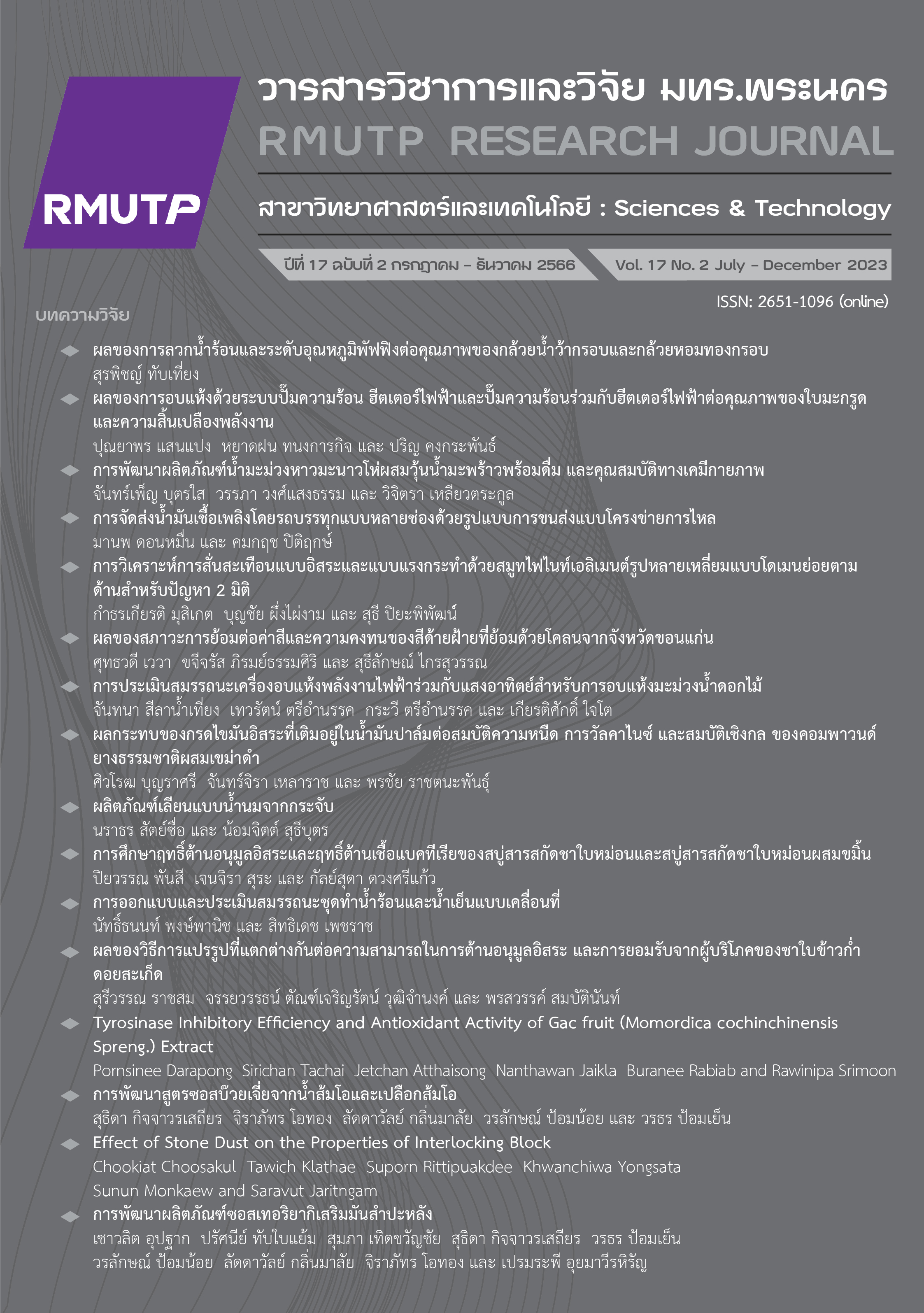Tyrosinase Inhibitory Efficiency and Antioxidant Activity of Gac Fruit (Momordica cochinchinensis Spreng.) Extract
Main Article Content
Abstract
This research evaluated the inhibitory efficiency of gac fruit (Momordica cochinchinensis Spreng.) extracts on tyrosinase and antioxidant activity. The results showed that ethanolic extract of aril had the highest tyrosinase inhibitory efficiency (80.57±0.50%), followed by peel extract and seed extract (p<0.05), respectively. The ethanolic extract of aril possessed the strongest tyrosinase inhibition of 1.28 fold compared with that of a standard inhibitor, kojic acid. Water extract of aril revealed the highest content of total phenolic compounds (1.291±0.011 mg GAE/g) and ethanolic extract of seed coat showed the strongest DPPH radical scavenging activity (63.18±0.34%). The inhibitory efficiency on tyrosinase associated with total phenolic content and antioxidant activity of the extract, especially in the ethanolic fraction. Our results can support the development of gac fruit extract for natural whitening products with further clinical study to confirm the efficiency and safety of the extract. It also enhances the economic value and reduces wastes of gac fruit, particularly peel and seed which were underutilized parts of fruit.
Article Details

This work is licensed under a Creative Commons Attribution-NonCommercial-NoDerivatives 4.0 International License.
ลิขสิทธ์ ของมหาวิทยาลัยเทคโนโลยีราชมงคลพระนครReferences
B. Halliwell, M. A. Murcia, S. Chirico and O. I. Aruoma, “Free radical and antioxidants in food and in vivo: what they do and how they work?,” Critical Review in Food Science and Nutrition, vol. 35, pp. 7-20. 1995.
K. B. Pandey and S. I. Rizvi, “Plant polyphenols as dietary antioxidants in human health and disease,” Oxidative Medicine and Cellular Longevity, vol. 2, no. 5, pp. 270-278. 2009.
C. Valadez-Vega, L. Delgado-Olivares, J. A. M. González, E. A. García, J. R. V. Ibarra, E. R. Moreno, M. S. Gutiérrez, M. T. S. Martínez, Z. P. Clara and Z. C. Ramos, “Chapter 16: The role of natural antioxidants in cancer disease,” in Oxidative Stress and Chronic Degenerative Disease-A Role for Antioxidants, J. A. Morales-González, Ed., InTech Open, 2013, pp. 391-418.
Y. S. C. Bae-Harboe and H. Y. Park, “Tyrosinase: a central regulatory protein for cutaneous pigmentation,” Journal of Investigative Dermatology, vol. 132, no. 12, pp. 2678-2680. 2012.
C. K. Okoro, A. T. Bull, A. Mutreja, X. Rong, Y. Huang and M. Goodfellow, “Lechevalieria atacamensis sp. nov., Lechevalieria deserti sp. nov. and Lechevalieria roselyniae sp. nov. isolated from hyperarid soils,” International Journal of Systematic and Evolutionary, vol. 60, no. 2, pp. 296-300. 2010.
K. N. Yoon, N. Alam, K. R. Lee, P. G. Shin, J. C. Cheong, Y. B. Yoo and T. S. Lee, “Antioxidant and antityrosinase activities of various extracts from the fruiting bodies of Lentinus lepideus,” Molecules, vol. 16, pp. 2334-2347. 2010.
R. Srimoon, Phenolic Compounds and Antioxidant Activity in Plants. 1st ed. Bangkok: Odeonstore Publishing, 2020.
A. V. Le, T. T. Huynh, S. E. Parks, M. H. Nguyen and P. D. Roach, “Bioactive composition, antioxidant activity, and anticancer potential of freeze-dried extracts from defatted gac (Momordica cochinchinensis Spreng.) seeds,” Medicines, vol. 5, no. 3, pp. E104. 2018.
J. Kubola and S. Siriamornpun, “Phytochemicals and antioxidant activity of different fruit fractions (peel, pulp, aril and seed) of Thai gac (Momordica cochinchinensis Spreng),” Food Chemistry, vol. 127, no. 3, pp. 1138-1145. 2011.
A. Abdulqader, F. Ali, A. Ismail and N. M. Esam, “Antioxidant compounds and capacities of Gac (Momordica cochinchinensis Spreng) fruits,” Asian Pacific Journal of Tropical Biomedicine, vol. 9, no. 4, pp. 158-167. 2019.
S. Oksana, B. Marian, R. Mahendra and S. H. Bo, “Plant phenolic compounds for food, pharmaceutical and cosmetics production,” Journal of Medicinal Plants Research, vol. 6, no. 13, pp. 2526-2539. 2012.
C. A. De Oliveira and M. F. Dario, “Bioactive Cosmetics,” in Handbook of Ecomaterials, L. M. T. Martínez, Ed. Springer International Publishing, 2018, pp. 1-23.
A. Manosroi, K. Kumguan, C. Chan khampan, W. Manosroi and J. Manosroi, “Nanoscale gelatinase A (MMP-2) inhibition on human skin fibroblast of Longkong (Lansium domesticum) Correa leaf extracts for anti-aging,” Journal of Nanoscience and Nanotechnology, vol. 12, pp. 1-11. 2012.
M. P. Kähkönen, A. I. Hopia, H. J. Vuorela, J. P. Rauha, K. Pihlaja, T. S. Kujala and M. Heinonen, “Antioxidant activity of plant extracts containing phenolic compounds,” Journal of Agricultural and Food Chemistry, vol. 47, pp. 3954-3962. 1999.
A. Chanwitheesuk, A. Teerawut gulrag and N. Rakariayatham, “Screening of antioxidant activity and antioxidant compounds of some edible plants of Thailand,” Food Chemistry, vol. 92, pp. 491-497. 2004.
C. Sanchez-Moreno, J. A. Larrauri and F. Saura-Calixto, “A procedure to measure the antiradical efficiency of polyphenols,” Journal of the Science of Food and Agriculture, vol. 79, pp. 270-276. 1998.
B. B. Li, B. Smith and M. M. Hossain, “Extraction of phenolics form citrus peels I: solvent extraction method,” Separation Science and Technology, vol. 48, pp. 182-189. 2006.
I. Bakhouche, T. Aliat, T. Boubel louta, L. A. Gali and Y. Bellik, “Phenolic contents and in vitro antioxidant, antityrosinase, and anti-inflammatory effects of leaves and roots extracts of the halophyte Limonium delicatulum,” South African Journal of Botany, vol. 139, pp. 42-49. 2021.
A. M. Muddathir, K. Yamauchi, I. Batubara, E. A. M. Mohieldinc and T. Mitsunaga, “Anti-tyrosinase, total phenolic content and antioxidant activity of selected Sudanese medicinal plants,” South African Journal of Botany, vol. 109, pp. 9-15. 2017.
J. Kim, S. C. Hong, E. H. Lee, J. W. Lee, S. H. Yang and J. C. Kim. “Preventive effect of M. cochinchinensis on melanogenesis via tyrosinase activity inhibition and p-PKC signaling in melan-A cell,” Nutrients, vol. 13, no. 3894, pp. 1-11. 2021.
H. Baek, H. Rho, J. Yoo, S. Ahn, J. Lee and J. Lee, “The inhibitory effect of new hydroxamic acid derivatives on melanogenesis,” Bulletin of the Korean Chemical Society, vol. 29, pp. 43-46. 2008.
Y. Kim, K. Kang and T. Yokozawa, “The anti-melanogenic effect of pycno genol by its anti-oxidative actions,” Food and Chemical Toxicology, vol. 46, pp. 2466-2471. 2008.


